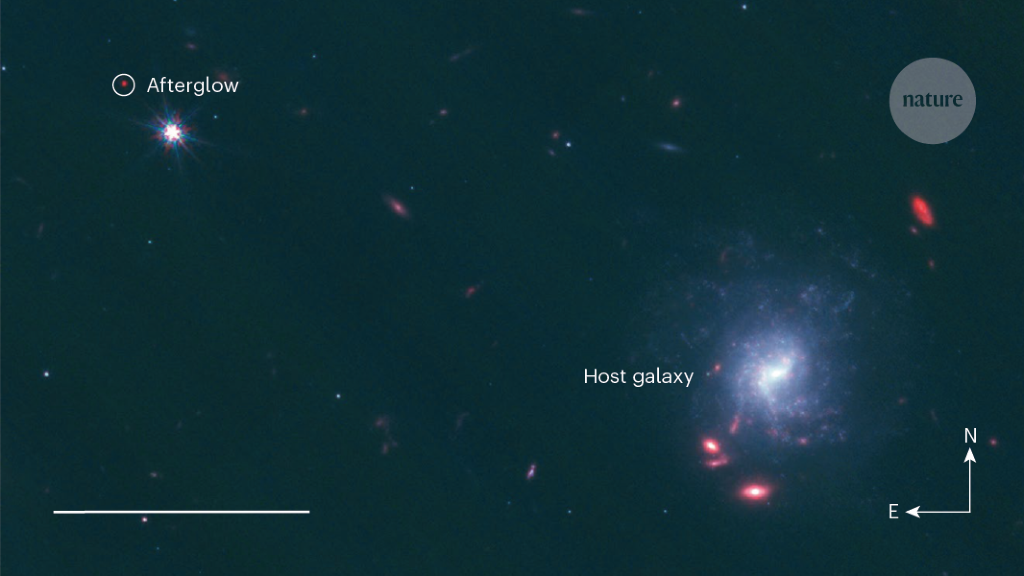Rare Isotopes Found in Prelude to Bright γ-ray Burst
Kernekoncepter
The authors argue that the red glow observed after a γ-ray burst was due to rare isotopes formed during the event, challenging previous assumptions about the causes of such bursts.
Resumé
In March 2023, astronomers observed GRB 230307A, the second-brightest known γ-ray burst. The focus shifted to the faint, colorful glow following the burst, transitioning from blue to deep red over weeks. Levan et al. and Yang et al. suggest that this red hue resulted from rare isotopes created during the triggering event, shedding light on cosmic element origins and raising questions about GRB causes.
Tilpas resumé
Genskriv med AI
Generer citater
Oversæt kilde
Til et andet sprog
Generer mindmap
fra kildeindhold
Besøg kilde
www.nature.com
Rare isotopes formed in prelude to γ-ray burst
Statistik
In March 2023, an astrophysical blast of γ-rays named GRB 230307A was registered as the second-brightest known burst of its kind.
The red color observed in the aftermath was attributed to rare isotopes synthesized during the event that triggered the burst.
Citater
Vigtigste indsigter udtrukket fra
by Daniel Kasen kl. www.nature.com 02-21-2024
https://www.nature.com/articles/d41586-024-00310-6
Dybere Forespørgsler
What implications could the discovery of rare isotopes in GRB aftermath have on our understanding of cosmic evolution
The discovery of rare isotopes in the aftermath of a γ-ray burst (GRB) can significantly impact our understanding of cosmic evolution. These isotopes, synthesized during the event that triggered the burst, provide crucial insights into nucleosynthesis processes occurring in extreme astrophysical environments. By studying these rare isotopes, astronomers can trace back to the conditions present during the early universe and gain a deeper understanding of how heavy elements are formed and distributed throughout space over cosmic timescales. This discovery opens up new avenues for investigating the origins and evolution of galaxies, stars, and planetary systems.
How might the presence of these rare isotopes challenge existing theories on γ-ray burst origins
The presence of rare isotopes in GRB aftermath poses a significant challenge to existing theories on γ-ray burst origins. Previously, it was thought that GRBs were primarily caused by cataclysmic events such as supernovae or neutron star mergers. However, the detection of radioactive glow from these rare isotopes suggests that there may be alternative mechanisms at play in triggering these powerful bursts of γ-rays. The synthesis and observation of such exotic nuclei point towards complex physical processes involved in generating GRBs that were not fully accounted for in previous models. This discrepancy challenges scientists to revise their current theories and develop more comprehensive explanations for the origin and nature of these energetic phenomena.
What other phenomena in space could potentially be linked to the formation of rare isotopes
Apart from γ-ray bursts (GRBs), several other phenomena in space could potentially be linked to the formation of rare isotopes. For instance, supernovae explosions are known to produce a wide range of elements through nucleosynthesis processes involving both rapid and slow neutron capture reactions. Neutron star mergers also offer fertile grounds for synthesizing heavy elements like gold and platinum due to their extreme conditions favoring r-process nucleosynthesis. Additionally, certain types of novae events involving white dwarfs accreting material from companion stars can lead to unique isotope production signatures. Exploring these diverse astrophysical scenarios provides valuable insights into how various astronomical sources contribute to enriching cosmic environments with rare isotopic compositions beyond what is typically observed on Earth or within our solar system.
0
